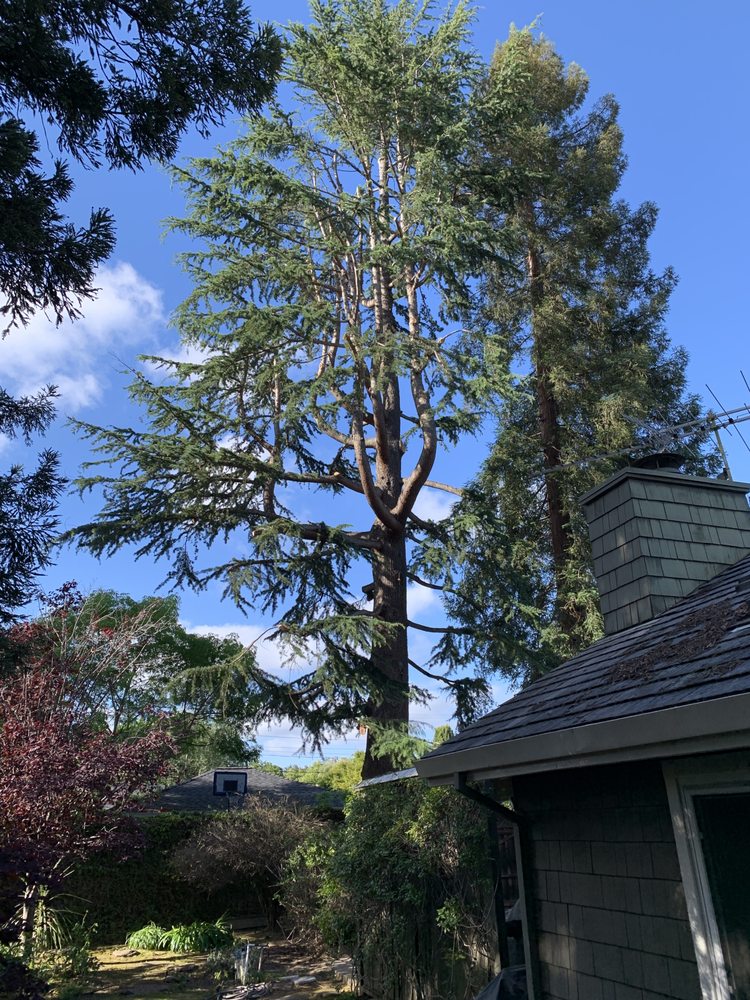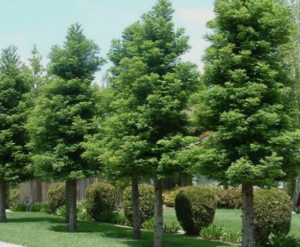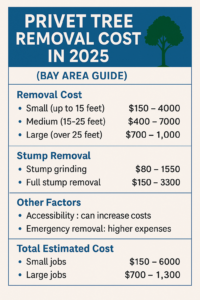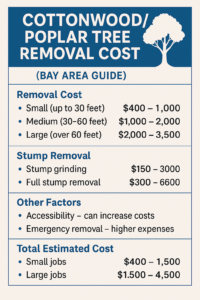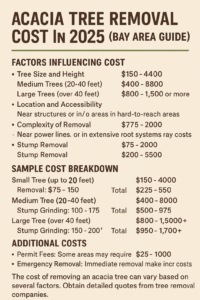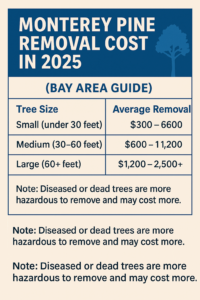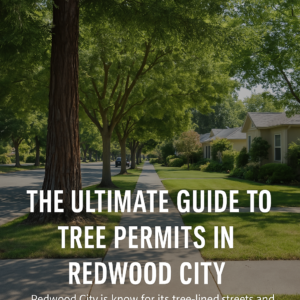Anyone not an arborist might find it tricky to tell whether tree trouble can be fixed by trimming or if it’s time to let the tree go. Removing a tree is extreme, but sometimes it’s the only way to create a safe, healthy environment. How can you know whether to cut away just a bit or make the big chop?
Trimming improves trees’ health, shape, and structure, protects against pests and diseases, and stops dead, diseased, or broken branches from becoming a safety threat. Tree removal prevents unstable, weakened trees from damaging property and power lines and injuring surrounding plants and people.
Here’s an arborist’s guide to tree trimming and removal, packed with tips to help you know which of these common care practices is right for your needs.
Understanding Tree Biology
When looking after our trees, we must understand how they grow, stay healthy, and respond to care practices like trimming.
Quick Guide to Tree Growth and Health
All trees share three main parts: roots, trunk, and crown (branches, leaves, flowers, and fruit). However, tree species have individual growth patterns that result in unique structures and forms. Whatever shape a tree develops, from columnar to round, depends on which buds and shoots grow fastest.
Healthy trees keep growing and have well-shaped crowns with lush leaves. Their trunks and branches show new growth every year.
More signs of tree health include:
- A symmetrically shaped crown
- Dark-green leaves or needles (unless they’re supposed to be purple or red)
- Full flowering and fruit production
Trees can only be healthy if they get enough air, sunlight, water, and nutrients to power their vital functions like making food and breathing.
Significance of Regular Tree Care for Longevity
While trees growing in the wild are good at looking after themselves, those in urban environments need some help.
You can boost your trees’ wellness by enriching their soil, watering them, and trimming them according to their needs.
Well-cared-for trees grow healthily, resist diseases and pests, and have strong branches. Regular tree care can add years to your tree’s life (and rings to its trunk!).
Tree Trimming
Appropriate tree trimming is a tree-care essential.
What is Tree Trimming?
When we talk about tree trimming, we mean cutting off parts of a tree to make it healthier, more attractive, or safer in the city environment.
Let’s look at this multi-purpose tree care practice in more detail.
Definition and Purpose
Tree trimming is the strategic and skillful removal of branches to achieve one or several goals.
Here are 10 reasons to trim your trees:
- Clear dead and damaged branches.
- Maximize longevity.
- Improve structure and shape.
- Let light and air into the crown or onto the ground below the tree.
- Prevent pest attacks and diseases.
- Give new trees a strong foundation.
- Make the area around the tree safe.
- Speed growth and fruit production.
- Enhance trees’ aesthetic value.
- Control overgrowth.
Essential Tools Used in Tree Trimming
The right tools help you to make precise cuts that heal quickly.
Add these to your trimming toolbox:
| Tool | What it is | What to use it for |
| Hand pruner | A compact cutter available in two styles: anvil (a sharp blade that cuts against a block) and bypass (works a lot like scissors). | Twigs and branches up to ½ an inch in diameter. |
| Lopping shears | Larger versions of the anvil and bypass pruners, with bigger blades and longer handles. | Branches with a diameter up to 1½ inches. |
| Pruning saw | A long, narrow blade with teeth at the bottom designed for pruning trees. | Branches bigger than 1½ inches in diameter. |
| Pole saw | A saw with a long handle or pole extension. | Branches you can’t reach. |
Remember these extras to keep you safe while snipping: safety goggles, gloves, and a hard hat (if you’ll trim big, high-growing branches).
The Benefits of Tree Trimming
Regularly trimmed trees are stronger, healthier, longer-living, well-structured, and more attractive.
These are the 3 top benefits of tree trimming:
- Enhancing Aesthetic Appeal
Trimming can improve trees’ natural shape and encourage them to flower.
- Preventing Tree Diseases and Pests
Insects and diseases are attracted to dead or damaged branches. Removing these branches protects the tree against threats.
- Increasing Sun Exposure and Air Circulation
Strategically removing branches from trees’ crowns allows light in and encourages airflow to lower disease risk.
When Should You Consider Tree Trimming?
There isn’t a one-size-fits-all approach to tree trimming. But there are ways to tell if the time is right.
Seasonal Guide for Tree Trimming
You can lightly trim or remove dead, damaged, or diseased branches throughout the year.
For all other types of trimming, be guided by this seasonal schedule:
| Winter | The best season to trim to encourage healthy growth is in spring. But hold off until the coldest days are over. It’s also the right time to trim trees that flower in the summer or fall. |
| Spring | Trees that flower in spring do best when trimmed just after their flowers fade. Avoid removing large amounts of foliage too soon after the growth period to prevent stressing trees. |
| Summer | Trim to control the size of trees. |
| Fall | Avoid trimming in the fall when tree wounds take longer to heal and the risk of fungal infection is higher. |
Indicators of Required Tree Trimming
Inspect your trees regularly and trim them only when there’s a reason to.
Here are signs your tree needs a trim:
- Dead, damaged, or diseased branches
- Weakly attached branches
- Branches growing inward
- Brunches rubbing against each other
- Branches interfering with activities happening below
- Overgrowth
- Branches growing toward power lines or buildings
- An asymmetrical crown
- Sprouts at the bottom of the trunk
- Multiple upright branches that compete with the main vertical branch at the top of the trunk
How to Trim Trees Safely and Effectively
You change your trees every time you trim them. Your efforts can either help them thrive–or cut their lives short.
Trimming trees safely and effectively is both a science and an art. You must know how to identify and remove flaws without leaving trees looking like they’ve been attacked.
DIY Tips for Small Trees
Here are dos and don’ts you must know before starting a DIY trimming project:
Do:
- Only trim when you have a reason to, whether it’s for safety, health, or aesthetics.
- Ensure your tools are always sharp and sterilized.
- Remove dead, damaged, and diseased branches as soon as you notice them.
- Stick to removing only 5 to 10% (or at most 15 to 20%) of a mature tree’s living foliage in one go.
- Keep your cuts as small as possible.
Don’t:
- Over-trim, especially when trees are stressed.
- Trim trees more than five times a year (unless you’re removing dead, diseased, and damaged branches).
- Chop off a mass from the top of a tree’s crown (topping).
Ready to start trimming? First read these pointers to help you perfect your cutting technique.
When to Call Professionals: Handling Large Trees
With know-how and care, you can successfully trim the small trees in your yard. Though trimming big trees introduces multiple challenges.
Take towering, heavy branches, add sharp cutting tools, and you have a potentially dangerous situation.
Trimming trees growing close to power lines is another hazardous task unsuitable for DIYers.
Ask a certified arborist to tackle all big or complicated trimming jobs. They have the equipment, knowledge, and expertise to practice the science and art of pruning. The pros can also share pointers for your smaller projects.
Tree Removal
Removal is the only solution when trees are a health or safety risk.
What is Tree Removal?

Tree removal involves taking out an entire tree, including its roots, or removing only its branches, leaving a stump behind.
Definition and Purpose
Special equipment and techniques cut a tree down to a stump or remove the entire tree, from crown to roots.
Tree removal prevents property damage, accidents, harm to surrounding plants, and obstacles to new construction.
Essential Tools for Tree Removal
Your chance of safe and efficient tree removal increases if you use the following tools and equipment:
- Cutting tools: lopping shears, pruning saws, pole saws, chainsaws
- Climbing equipment: ropes, belts, harnesses, lanyards, slings, carabiners
- Safety equipment: hard hat, gloves, non-slip boots, leg protection, safety goggles, face shield, hearing protection
The Importance of Tree Removal
Removing a tree should be a last resort. Still, sometimes, it’s the only option to create a safe, healthy environment or allow for new construction.
Safety Reasons: Removing Hazardous Trees
Trees become hazardous when they’re likely to fall onto a building, vehicle, power line, or person.
These are warning signs of tree hazards:
- Dead trees
- Decaying trees
- Trees leaning more than 15 degrees
- Trees with cracks or major wounds on their trunks
- Tree roots that have lifted the soil
Making Way for New Construction
Trees can be hazards or obstructions to new construction. If it’s impossible to build around an existing tree, the tree must be removed before construction can proceed.
Managing Diseases and Pests
Trees targeted by diseases and pests often need to be removed to stop surrounding plants from being infected or attacked.
When Should You Consider Tree Removal?
Learn how to spot dead, dying, diseased, and pest-infested trees.
Identifying Dead or Dying Trees
Watch out for these warnings that a tree is dying:
- Lacking leaves when all other trees have full foliage
- Damaged trunk stripped of bark
- Fungi feeding off a sickly tree or on the surrounding ground
- Wide vertical cracks in the tree trunk
To check if a tree is dead, select branches in several areas and scratch their underside with a knife. The tree is likely dead if you don’t see any green where you scratched.
Recognizing Tree Diseases and Pest Infestations
These are red flags your tree might have a disease that’s weakening its structure and turning it into a hazard:
- Slowed growth
- Noticeable twig and branch dieback
- Undersized leaves or needles
- Leaf discoloration and leaf or needle drop (before the fall)
- Excessive seeds or cones
- Mushrooms, conks, or shelf-like structures
Pest infestations show themselves in different ways. Here are general signs your tree is dealing with a pest problem:
- Damaged, discolored, abnormally sized leaves
- Holes in leaves
- Suddenly thinning foliage
- Branch growth that’s less than in previous years
- Holes and frass on the trunk
- Lifting roots
Arbor Day Foundation Arborist Pete Smith explains how to spot a pest infestation. (YT link:https://youtu.be/LUShQaEXmMA)
How to Safely Remove Trees

Thorough safety training minimizes the risks associated with tree removal.
Precautions for DIY Tree Removal
Ideally, only experienced tree removal professionals should take on this dangerous practice.
Familiarize yourself with these basic precautions before even thinking about DIY tree removal:
- Do a hazard check to identify all potential dangers. Watch out for trunk rot, cracks, splits, and cankers; nests and hives; poisonous plants in the surroundings; interlocking vines or branches from another tree; anything attached to the top of the tree; nearby fences or power lines.
- Ensure all tools and equipment are in good working order.
- Don’t work in bad weather or poor light.
Here are more must-know safety guidelines for tree work.
Understanding the Necessity of Professional Services
Tree removal poses serious risks, such as damage to property or surrounding vegetation and accidents that can cause injury or death.
Experienced certified arborists know how to conduct full risk assessments and devise plans to remove trees safely.
Tree Trimming vs. Tree Removal: Making the Right Decision
Suppose you’re still unsure whether you can snip away your tree problems or need more drastic action.
Various factors shape whether tree trimming or removal is the solution you need. A certified arborist will consider all these factors and advise you on the best course of action.
Before deciding whether to trim or remove trees, here’s what you must think about:
Evaluating Your Situation: Key Factors to Consider
Not all sickly or damaged trees must be removed. For example, trimming can restore storm-damaged trees with no cracks in their major limbs or trunk and no exposed roots. Trimming can also often help trees regain their health when diseases and pest infestations are identified early.
However, sometimes trees can’t be saved, and keeping them in your yard risks your safety and other plants’ health.
Here are general guidelines to help you know whether a tree can be saved or must be removed:
| It’s possible to save the tree if… | Tree removal is likely the only option if… |
| Less than 50% of the tree is damaged | More than 50% of the tree is damaged |
| Severe damage covers less than 25% of the trunk’s circumference | More than 25% of the trunk’s circumference is severely damaged |
| Less than a third of the trunk is hollow or rotten | A third or more of the trunk is hollow or rotten |
| Less than 25% of large branches are damaged | More than 25% of large branches are damaged |
| Dead branches aren’t on only one side of the tree | All dead branches are on one side of the tree |
| Less than 50% of the root system is damaged | More than 50% of the root system is damaged |
| It has a slight lean | It’s leaning more than 15% from vertical |
Environmental Considerations: Impact on Local Ecosystem
Healthy trees are essential to a thriving environment.
They give wildlife and beneficial insects a home and food source, provide oxygen, clean and cool the air, trap carbon dioxide, prevent soil erosion, and boost surrounding plants’ well-being (by drawing water to the upper soil layers and transferring nutrients).
Economic Considerations: Cost-Benefit Analysis
Healthy trees offer financial perks like boosted property values and dropped home cooling costs. They also give benefits like reduced noise pollution, increased privacy, shade, beauty, and feelings of well-being.
These benefits often offset trimming and other care costs, especially for trees with long lifespans or historic or sentimental value.
Then again, if a tree is a health or safety threat, removal is the smart move to prevent expenses associated with property damage or pests and diseases spreading all over your garden–not to mention the cost of injury or death if the tree falls on someone.
Legal Considerations: Local Laws and Regulations
Trees are a valuable resource worth protecting, so cities have established laws and regulations to prevent them from being removed without a good reason.
These trees are more fiercely protected than others and subject to stricter regulations:
- Trees with a large trunk diameter
- Important native species or trees associated with the character of a community
- Very old trees
- Trees with historic significance
- Trees with especially high ecological value
- Trees growing in specific locations
- Trees planted as a requirement of development
Hiring Tree Service Professionals
Here’s how to find a pro team to complete the job without a hitch.
When and Why to Hire a Professional
Hire a certified arborist to remove trees, trim large trees, or advise you when you need help caring for your trees properly.
Reputable, qualified, experienced tree professionals can minimize the danger of working at heights with heavy machinery and sharp tools. They also use the least-invasive tools and techniques.
The pros can also ensure care practices don’t have the opposite effect, leaving trees more vulnerable to pests and diseases, with a poor structure, messy, and stressed.
What to Look for in a Tree Service Company
When selecting a tree service company, look for a team of experienced certified arborists. These professionals have proven their knowledge of tree biology, proper care practice, and safety protocols.
Questions to Ask Before Hiring
Don’t hire an arborist if you’re not happy with their answers to these questions:
- Are you certified?
- What qualifications do you hold?
- What is your tree care experience?
- Are you insured against personal injury and property damage?
- Do you comply with local regulations?
- Do you use ethical, industry-accepted standards and practices?
- Do you have references from your previous tree trimming and removal jobs?
- Could you give me a written detailed project estimate?
Summary
Regular care keeps trees healthy, resistant to pests and diseases, attractive, and long-lived. Although tree trimming is an important part of tree care, trimming large trees and removals are dangerous practices suitable for only trained, experienced tree professionals.
Tree removal has environmental, economic, and legal implications. The main reasons for tree removal are eliminating hazardous trees, managing diseases and pests, and making way for new construction.
Bringing out the best in your trees comes down to understanding and meeting their changing needs. If you’re unsure how best to care for your trees, call in an experienced certified arborist.
Frequently Asked Questions
What are the risks of DIY tree trimming and removal?
DIY tree trimming and removal risks include tree harm, accidents, and property or surrounding vegetation damage.
How often should I schedule professional tree maintenance?
Schedule professional tree maintenance around your trees’ needs. Trees’ species, age, and health status influence how much care they require. Ask a certified arborist to look at the trees in your garden and recommend a personalized maintenance schedule.
What is the best time of year for tree trimming or removal?
Late winter or early spring are the best times for tree trimming and removal.
How to identify diseased or dying trees?
Signs of diseased or dying trees include sparse foliage, discolored or undersized leaves, stripped bark on trunks, large vertical trunk cracks, slow growth, holes in the trunk or leaves, and mushrooms, conks, or shelf-like structures on or close to the tree.
Resources
https://nasdonline.org/1952/d001878/tree-trimming-safety.html
https://pubs.nmsu.edu/_h/H156/index.html
https://www.britannica.com/plant/tree/Adaptations
https://www.dec.ny.gov/docs/lands_forests_pdf/prunetree.pdf
https://apps.msuextension.org/magazine/assets/docs/TreeHealth.pdf
https://www.thespruce.com/how-to-tell-if-tree-is-dead-6827047
https://www.dir.ca.gov/dosh/dosh_publications/Tree-Work-Safety-Guide.pdf
